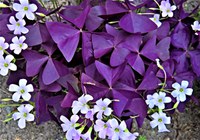Dakota Gardener: Lucky shamrocks
(Click an image below to view a high-resolution image that can be downloaded)
By Kelsey Deckert, Horticulture agent
NDSU Extension - Burleigh County
Do you love to partake in St. Patrick’s Day festivities? Many of us do, whether it is simply wearing green, setting up leprechaun traps with your kids or enjoying a green beer!
There are many traditions associated with this Irish celebration, such as finding a shamrock that will bring you good luck. Legend has it that St. Patrick used shamrocks for teaching the Holy Trinity.
In the month of March, shamrocks can be easily found at local greenhouses and nurseries. What exactly is a shamrock? Have you ever found a three- or four-leaf clover in the landscape?
Shamrock is an Irish word that means little clover, though it is unrelated to clover. Shamrocks are a species of Oxalis, also known as woodsorrels. If you see a shamrock in your yard it is most likely yellow woodsorrel. Unless you are trying to incorporate more pollinators in your landscape or are a low-maintenance gardener, it is considered a weed.
Yellow woodsorrel has thin, green stems and may take root where the nodes touch the ground. It also has dainty yellow flowers that can attract pollinators.
The shamrocks that are sold in local greenhouses are different varieties of Oxalis that make great houseplants. Most have three or four leaflets. The leaves come in shades of green, red or purple. They also have flowers that can be white, yellow, pink or red.
Shamrocks are easy to care for preferring slightly moist, well-drained soils. They do best in bright, indirect light with cool nighttime temperatures. Their leaves may even fold inward at night or on an overcast day.
If you have a shamrock houseplant, you will want to fertilize monthly while it’s actively growing. After a few months the plants will start to decline and go dormant. When you notice the leaves are starting to die back, stop watering and allow the leaves to dry out and turn brown. Remove the dead leaves and place your shamrock in a cool, dark spot for 2 to 3 months depending on the variety for a rest period. After the rest period, move the container back to a bright window and begin watering and fertilizing. Sometimes you may need to repot the shamrock.
With St. Patrick’s Day upon us, consider getting a “shamrock” to bring some luck to your life or just to simply enjoy this wonderful houseplant.
For more information about woodsorrels, contact your local NDSU Extension agent. Find the Extension office for your county at ndsu.ag/countyoffice.
NDSU Agriculture Communication – March 14, 2024
Source: Kelsey Deckert, 701-221-6865, kelsey.j.deckert@ndsu.edu
Editor: Kelli Anderson, 701-231-7006, kelli.c.anderson@ndsu.edu




